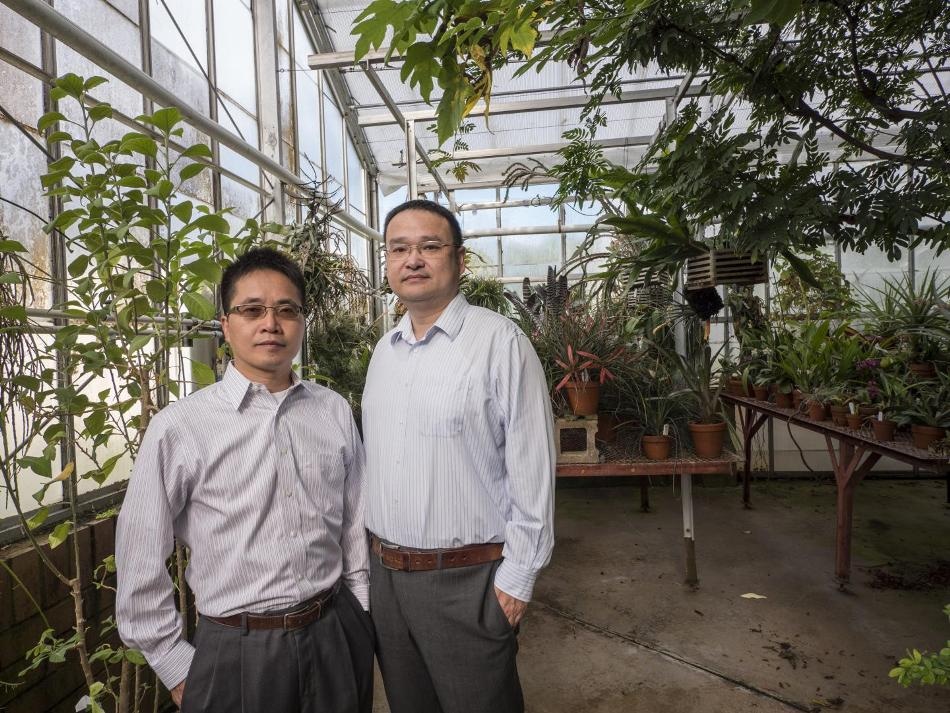Jan 17 2018
Engineers at University of Colorado Boulder have been given a $2.45 million grant from the U.S. Department of Agriculture (USDA) to create a scalable, economical greenhouse material that splits sunlight into photosynthetically efficient light and repurposes unproductive infrared light to assist in water purification.
 Assistant Professor Ronggui Yang (left) and Assistant Professor Xiaobo Yin in a greenhouse on the University of Colorado Boulder campus. (Photo credit: Glenn Asakawa /University of Colorado Boulder)
Assistant Professor Ronggui Yang (left) and Assistant Professor Xiaobo Yin in a greenhouse on the University of Colorado Boulder campus. (Photo credit: Glenn Asakawa /University of Colorado Boulder)
The four-year research program could produce next-generation technology that can solve food, water and energy security challenges posed by world’s population growth and climate change.
The research, administered under the USDA and National Science Foundation's Innovations at the Nexus of Food, Energy and Water Systems (INFEWS) program, will be headed by researchers from CU Boulder's Department of Mechanical Engineering in partnership with Michigan State University's Department of Horticulture.
"We are excited to work on a project that addresses one of the most important global challenges with our multidisciplinary colleagues at CU and MSU," said Assistant Professor Ronggui Yang, who will lead the team.
Greenhouses have been used since the 1960s and are still the standard for effective plant productivity compared to open field agriculture. But the structures bring high energy costs, requiring incredible quantities of energy for ventilation, heating, electrical lighting, and water for evaporative cooling. By the year 2050, existing greenhouse capabilities will probably be incapable of keeping up with global human consumption, making an increase in productivity a pressing mandate.
Under regular conditions, plants just use about 50% of incoming sunlight for photosynthesis while the rest half goes unexploited.
The new CU Boulder technology will take the form of a semi-translucent film that splits incoming light and converts the rays from less-desired green wavelengths into more desirable red wavelengths, thus increasing the amount of photosynthetically efficient light for the plant with no additional electricity consumption.
Xiaobo Yin, Assistant Professor of Mechanical Engineering and Materials Science and Engineering, CU Boulder.
The thin engineered material can be applied straight to the surface of greenhouse panels.
The technology also utilizes the photosynthetically ineffective light by redirecting it to assist in solar-driven water purification, an application that MSU professors James Klausner, Andre Benard and Erik Rungle will work to advance further.
"The near-infrared wavelengths can help clean brackish wastewater, allowing it to be recirculated in an advanced humidification-dehumidification interface and further reducing the greenhouse's energy footprint," said Yang.
The innovation could help enhance U.S. agricultural competitiveness and bring about new best practices for greenhouse systems in various climates, especially in dry regions with inadequate freshwater availability where crops cannot be grown gainfully.
The technology expands on the researchers' earlier successful efforts to create a collection of scalable engineered materials that can cool structures and enhance solar panel efficiency, among other applications.
The researchers plan to develop a pilot greenhouse facility to analyze the material's properties over the course of various tomato production cycles and, later, expand the test to leafy greens such as herbs and lettuce.